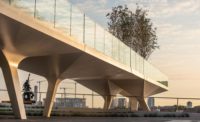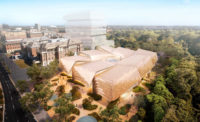Earlier this year, Diller Scofidio + Renfro unveiled a sprawling new home for the Juilliard School in Tianjin, China. But a Chinese project begun a decade earlier–a live-work campus in Dongguan, in the Pearl River Delta Economic Zone–is still under construction. The project, a mega-building of almost one million square feet, is the brainchild of Li Jing Zhou, owner of the handbag company Dissona. Hoping to use design to improve the plight of Chinese workers, she sought out the New York architecture firm. Partner-in-charge Charles Renfro made almost a dozen visits to the site, which, he says, is surrounded by a vast expanse of dreary factories and rudimentary workers’ housing.
He and Zhou developed a scheme in which the various strands of the Dissona operation–design, management, manufacturing, as well as living quarters for 3,000 workers, and entertainment, dining, and recreational facilities–would be woven into a single complex. The mammoth building is almost a diagram of the company’s parts, with voids becoming landscaped courtyards. The client completed the exterior of the concrete-framed building and built out parts of the interior, some of which are now in use, before declining sales forced a construction slowdown.
After commissioning a new set of exterior photos by Zhang Chao, Renfro spoke to RECORD about the evolution of the project.
How did the project come about?
It was our first foray into China. What we liked, the reason we took the project, is that the client wanted a factory and residential complex with facilities for leisure and education unlike anything else in the region. We got excited about working with an interested and informed client to help release her workers from the grueling and thankless lives that they typically lead.
How did you begin?
We helped develop the program, with ideas for things we thought should be included. We wanted to make it feel like home, with a town square that was contained and nurturing but was also designed so that thousands of people could sit on a lawn and see a movie. And we designed a school where the workers could learn language and computer skills. The client’s hope was that her workers would either stay with her and move up through the ranks or leave with skills they didn’t have when they came in. She wants to use architecture to elevate their lives.
How much is built?
The entire exterior is complete, and I am very pleased with the construction. You can see the quality of the facades, with the metal louvers that allow in light and air but provide sun-shading, which is important for sustainability. It’s an innovative facade, which we developed with Front Inc. [the Brooklyn-based facade consultant], to solve a number of practical problems and also to give the building its unifying architectural expression. We call the undulations in the aluminum louvers “eyelids.” There are two sizes–smaller ones for the dorm rooms and bigger ones for the factory spaces. The parts of the building that don’t have eyelids–the stacked boxes–contain education and dining facilities in one case and Dissona’s fashion showrooms in the other.
The quality is high by local standards?
Yes. The client respected the design work. Having brought in a western architect, she also adopted a more western concept of how high-quality buildings are made.
The company R&D’d the facade, with a series of mock-ups, and chose the best manufacturer. It was a very good company to work with.
But then something went wrong?
The client couldn’t anticipate the vicissitudes of the market. We’re told that right now they are only occupying a quarter of the facility. The management offices are positioned in the middle of the workers’ housing, so the workers would pass through them on a daily basis. But those offices aren’t finished yet. And the design studios are actually embedded in the assembly lines, so the workers can see the designs come to life. The idea is that everyone gets to witness everything that’s happening on the campus. But that hasn’t been proven out yet.
What have you achieved?
One thing that has been successful is that the factory spaces are long and narrow and have natural light on both sides, as well as cross-ventilation (although there’s also air conditioning). The height of the spaces, more than 16 feet, makes them pleasant to be in.
We also changed the nature of the dormitory rooms. We designed them to house four people each. At some factories, there can be eight or twelve people to a room, with only one window for everyone. We made them a bit more like hotel rooms; each bed has its own operable window, and then there’s a communal window as well. And there’s a study area that separates the bedroom from the bathroom, where we upgraded the finishes to tile and stone.
One of the innovative things that the client was thinking of doing was giving her workers an extra housing allowance and having them in turn pay rent. They’d have the option of finding their own housing off-campus, so she could gradually shrink the density of her housing from 4 to a room to 2 or even 1 to a room. And she is considering renting some units to outsiders. So the population of the complex would not just be the monoculture of factory workers. That would be innovative both socially and economically.
Why the courtyards?
We knew we couldn’t depend on external views for beautiful scenery or fresh air. So we needed to make our own internal landscape that was beautiful, as a defense against the ugliness of Dongguan. But the landscape hasn’t been completed yet.
How do you feel about the project now?
I’m very proud of it. I’d like to think it’s a significant contribution to a building type that is pervasive but that western architects rarely touch. Chances are you buy something from a factory in the Pearl River Delta every day. But a factory by a western architect in China–that has never happened before.
Will it get finished?
The architect can’t make the client complete the building. But this client is actually quite good at turning on a dime. So we’re optimistic.







Post a comment to this article
Report Abusive Comment